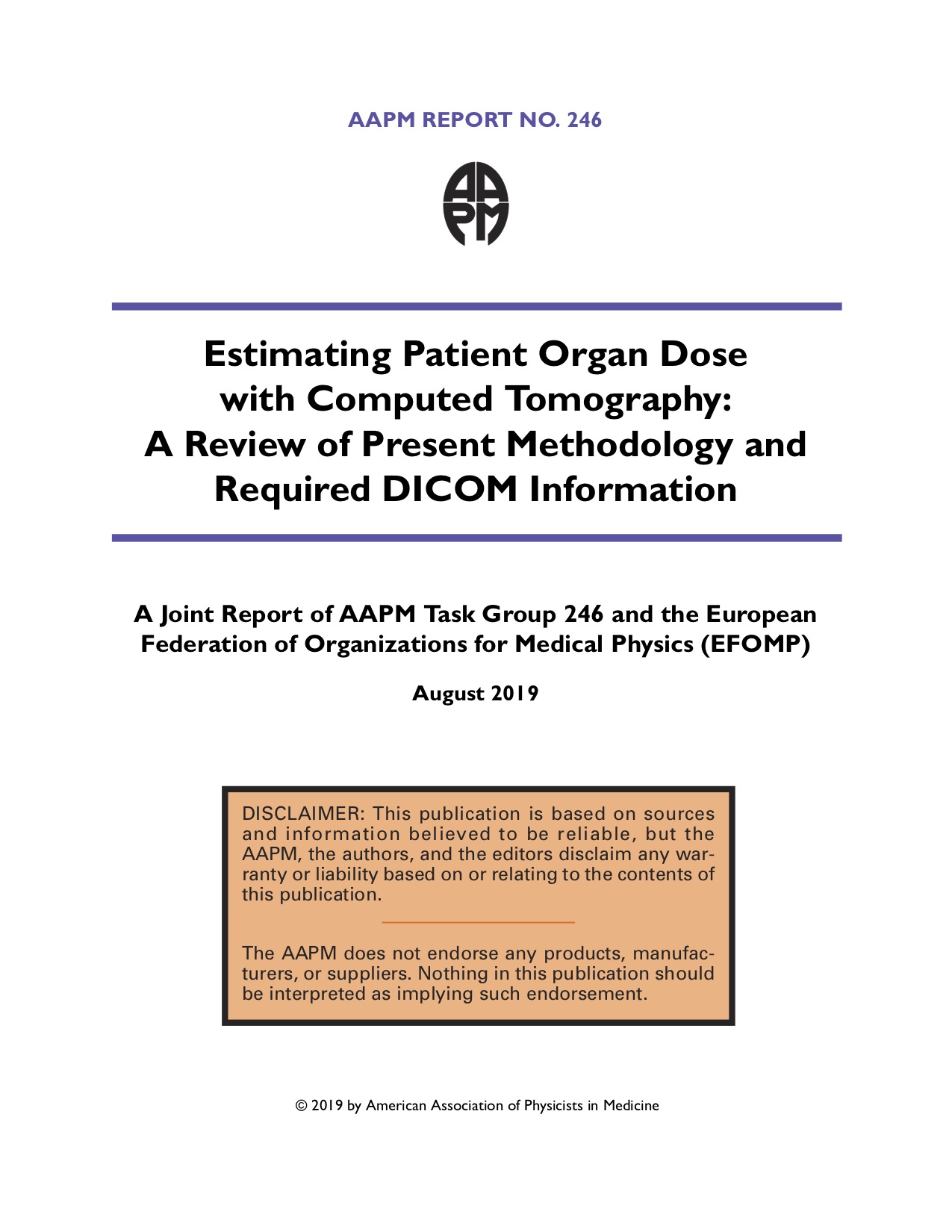
|
Report No. 246 - Estimating Patient Organ Dose
with Computed Tomography:
A Review of Present Methodology and
Required DICOM Information A Joint Report of AAPM Task Group 246 and the European Federation of Organizations for Medical Physics (EFOMP) (2019) Category: Reports 1. Introduction The radiation absorbed dose or ‘dose’ that a patient receives from a routine CT examination is considered to yield very low risk of harm when properly used to obtain a diagnostic benefit, i.e., when the justification and optimization of a given examination have been taken into account.1 However, a gap is recognized in the ability of the conventional CT radiation dosimetry metrics—the Computed Tomography Dose Index (CTDI) and Dose Length Product (DLP)2—to accurately represent individual patient organ doses. Organ dose is generally regarded as one of the best metrics to quantify individual radiation burden. 1.1 Purpose and Overview The purpose of this report is (1) to summarize the current state of the art in estimating organ doses from CT examinations and (2) to outline a road map for standardized reporting of essential parameters necessary for estimation of organ doses from CT imaging in the DICOM standard. To address these purposes, the report includes a comprehensive discussion of (1) the various metrics, concepts, and methods that may be used to achieve estimates of patient organ dose and (2) the DICOM standard for CT. This Joint Report of the American Association of Physicists in Medicine (AAPM) Task Group 246 and the European Federation of Organizations for Medical Physics (EFOMP) contains three major sections and an appendix. Section 2 (with additional material in the appendix) provides a review of basic CT dosimetry metrics, their uses and limitations in the context of organ dosimetry, and the DICOM information currently associated with parameters that affect CT dose metrics and, consequently, organ dose estimates. Section 3 provides an overview of present and emerging organ dose estimation methods reported in the literature, e.g., for the lens of the eye, breast tissue, colon, and skin. Finally, the report concludes with section 4, which provides a discussion on the sources and magnitudes of uncertainty for different organ dose estimation methods. Ongoing efforts to facilitate routine standardized estimation of patient organ doses from CT are dependent, in large part, on the availability of the DICOM Radiation Dose Structured Report (RDSR), which provides a host of information pertinent to radiation dose calculations. This report, therefore, includes detailed information on DICOM header content in CT images and how it can be used in organ dose estimation. The RDSR markedly expands the abilities of the clinical medical physicist to estimate doses at the patient, device, and protocol level. https://doi.org/10.37206/190 ISBN: 978-1-936366-72-9 Keywords: Computed tomography, Radiation dosimetry, Dosimetry metrics, Organ dose estimates, Monte Carlo methods, Source modelling, Computational phantoms, DICOM information, Uncertainty estimates Jonas Andersson, William Pavlicek, Rani Al-Senan, Wesley Bolch, Hilde Bosmans, Dianna Cody, Robert Dixon, Paola Colombo, Frank Dong, Sue Edyvean, Jan Th. Jansen, Kalpana Kanal, Shuai Leng, Qing Liang, Cynthia McCollough, Ed McDonagh, Michael McNitt-Gray, Robert Paden, Madan Rehani, Ehsan Samei, Ioannis Sechopoulos, Mark Supanich, Christie Theodorakou, Xiaoyu Tian, Alberto Torresin, Annalisa Trianni, David Zamora, Federica Zanca Committee Responsible: Computed Tomography Subcommittee Last Review Date: |
DISCLAIMER



















